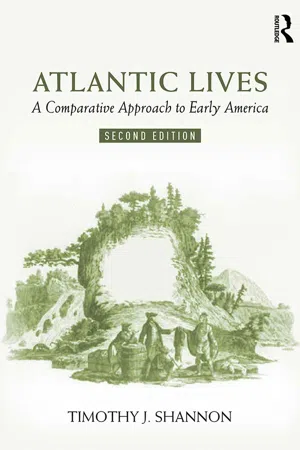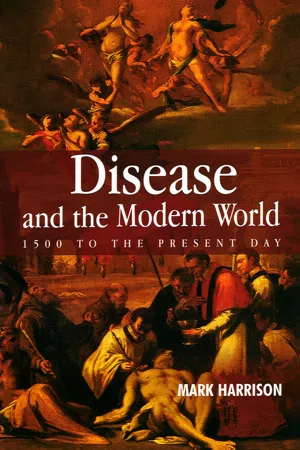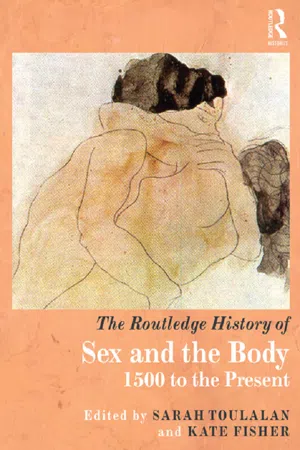History
Columbian Exchange Diseases
The Columbian Exchange Diseases refer to the transfer of infectious diseases between the Old World and the New World following the arrival of European explorers in the Americas. This exchange led to devastating consequences for the indigenous populations, as they had no immunity to diseases such as smallpox, measles, and influenza. The resulting epidemics caused significant population declines in the Americas.
Written by Perlego with AI-assistance
Related key terms
4 Key excerpts on "Columbian Exchange Diseases"
- eBook - ePub
Atlantic Lives
A Comparative Approach to Early America
- Timothy Shannon(Author)
- 2019(Publication Date)
- Routledge(Publisher)
2 The Columbian ExchangeFigure 2.1 Smallpox among the Nahuatl in Sixteenth-Century Mexico.Of the many diseases transmitted across the Atlantic in the Columbian Exchange, smallpox was the most deadly for Native Americans (see Selection 2). Considered a childhood disease in Europe, in America it led to fatality rates that ranged from 30 to 90 percent of infected populations. This image of Native Americans suffering from smallpox comes from a sixteenth-century Spanish collection about the Aztecs.Source: Florentine Codex, Book XII folio 54. Bernardino de Sahagún, Historia general de las cosas de la Nueva España (1540–1585).Introduction
The passage of human beings between the Old World and the New led to a much wider transfer of plant and animal life commonly known as the Columbian Exchange. Some of this exchange occurred by design, such as when Old World farmers planted American crops in their fields; other times, the exchange was inadvertent, such as when colonists unwittingly introduced new diseases to Native American populations. Whether purposeful or accidental, such exchanges forever altered the nature of plant, animal, and human life on both sides of the Atlantic. Formerly isolated ecosystems became intertwined and transformed in the process. Some species experienced extinction or near extinction, while others flourished in new surroundings unchecked by natural enemies. While scholars have typically studied the human actors involved in this drama, we cannot appreciate the full impact of the Columbian Exchange without considering the other forms of life it affected.The most profound changes wrought by the Columbian Exchange resulted from the transmission of microbes from the Old World to the New. European sailors, explorers, traders, and colonists brought to the Americas a number of diseases to which Native Americans had had no previous exposure, and therefore, no natural immunities. Smallpox, measles, influenza, bubonic plague, and others broke out in “virgin-soil epidemics” among these new host populations. Estimating the impact that these diseases had on Native Americans has become a contentious business among scholars, involving debates over the pre-Columbian population of the Americas and the fatality rates associated with virgin-soil epidemics. On the high end, some scholars estimate that as many as 18 million Indians lived in North America prior to 1492, and that Old World microbes reduced that number by as much as 95 percent. More conservative estimates place the pre-Columbian population of North America at 4–7 million, with a 60–70 percent reduction in that number by 1700. - Mark Harrison(Author)
- 2013(Publication Date)
- Polity(Publisher)
4 The World beyond EuropeNew World peoples, Old World diseasesThe world that emerged from the Renaissance and the Reformation was a world that looked increasingly to the future. Though scholars and statesmen still revered Classical civilization, they looked forwarded in confident anticipation of progress. They looked increasingly beyond Europe, too. The rise of the West depended very largely on its willingness to seek out, and ultimately to control, new lands, commodities and peoples.1 In the process, Western medicine was confronted with new challenges and opportunities, in the forms of disease and medicinal plants. And with the movement of peoples came the passage of microbes, hastening what Emmanuel Le Roy Ladurie has described as the ‘unification of the globe by disease’.2 But while germs were distributed far more widely than before, the burden of disease was far from equal. Long exposure to infections like smallpox and measles gave Europeans an immunity that the peoples of America and the Pacific lacked. In the Old World there were more domesticated animals, which acted as reservoirs of infection, and all the key centres of population had long been joined by trade, which ensured regular mixing of germs.3 Once Europeans landed in the New World, Old World infections spread rapidly and fatally among the local inhabitants, leaving Europeans relatively unscathed. Spanish censuses and tax surveys suggest that the indigenous population halved within two decades after the first reported epidemics.4The best-known account of these epidemics is Alfred W. Crosby’s book, The Columbian Exchange (1972).5 Crosby argues that the importation of lethal pathogens was one aspect of a process of ‘ecological imperialism’ that allowed white settlers rapidly to attain dominance over Native Americans.6- eBook - ePub
Plagues upon the Earth
Disease and the Course of Human History
- Kyle Harper(Author)
- 2021(Publication Date)
- Princeton University Press(Publisher)
86The full brunt of European disease was felt even later in the interior and west of North America. Smallpox diffused across the Great Plains from the later eighteenth century. Elizabeth Fenn has traced the forgotten western loop of the smallpox epidemic of the 1770s and 1780s; the outbreak in the backdrop of the American Revolution was an almost continent-wide event that swept across the Plains. Smallpox epidemics continued to strike into the nineteenth century, and native voices underscore the deadliness of these events and their role in white expansion. In one Kiowa legend, Uncle Saynday, a trickster who protected the Kiowa people, was roaming the prairie when he saw “a dark spot” moving toward him from the east. As Saynday approached, he saw it was a man on a horse, his face “pitted with terrible scars.” The stranger announced himself as “Smallpox.” “I come from far away, across the Eastern Ocean. I am one with the white men—they are my people as the Kiowas are yours. Sometimes I travel ahead of them, and sometimes I lurk behind.… I bring death. My breath causes children to wither like young plants in spring snow. I bring destruction. No matter how beautiful a woman is, once she has looked at me she becomes as ugly as death.” The Kiowas suffered repeated encounters with smallpox throughout the nineteenth century, and the horrifying disease winnowed their numbers.87Along the Pacific Coast, the sharpest impacts were felt in the early nineteenth century. As we will see in chapter 11 , the epidemics on the coasts of Oregon and California belong largely to Pacific history and the story of European seaborne expansion in the great ocean. Decades before the California gold rush, new diseases arrived in the lush valleys inhabited by a rich mosaic of native societies. In the 1830s malaria reached the swarms of mosquitos that awaited en masse in the moist lowlands. The mortality was “lurid.” Then came smallpox—first from Russian Alaska in 1837, then again in 1844, 1854, and 1862. Where indigenous people had been crowded into missions, the slaughter was catastrophic. And then came the crush of desperate and gold-hungry settlers, willing to finish what has been called, with due consideration, a genocide. The California gold rush in many ways completes a circle that had started when Columbus eyed the gleam of the yellow metal in the jewelry of the Taí no natives some three and a half centuries before.88 - eBook - ePub
The Routledge History of Sex and the Body
1500 to the Present
- Sarah Toulalan, Kate Fisher(Authors)
- 2013(Publication Date)
- Routledge(Publisher)
Historians rely on periodization, the practice of defining certain eras as distinct from others. Like rivers that help form geographic boundaries, historians use great events to demarcate ages. The dawn of early modernity is marked by a litany of developments in the vicinity of 1500 said to terminate the middle ages: Gutenberg’s press, Columbus’ journey, Luther’s shattering of Christian unity, Copernicus’ transposition of earth and sun. After these events, we are told, the middle ages were no more. Although it is not invoked with the same gravity as these legends of textbooks, yet another event changed European life at the close of the fifteenth century: the 1494 emergence of a lethal disease that will eventually be called syphilis. For the history of sexuality it helps ring in a new age.The disease spawned one of history’s longest recorded debates, running into this its sixth century. Did it return with Columbus or was it a new strain of an existing disease? Nowadays syphilis’ origin falls to paleopathologists studying pre- and post-Columbian bones on opposite sides of the Atlantic. But for all the power of techniques like carbon dating, the jury is still out.1 The tide of opinion has long supported the view characterized by Alfred Crosby’s phrase ‘the Columbian Exchange’, which sees Europeans and Americans trading smallpox for syphilis.2 In these histories white sailors’ bodies shuttle microbes across the ocean introducing them to ill-prepared populations with bad consequences for Europe and genocidal ones for America.3 With recent awareness of environmentalism and globalization, meta-narratives on the global history of disease, in which the Columbian exchange plays a central role, have been powerful.4 However, recent analysis of pre-Columbian English skeletons with possible signs of syphilitic damage ensures that the debate continues.5For paleopathologists the history of syphilis hinges on the presence or absence of a bacterium, Treponema pallidum. However, other scholars resist reducing the disease to the pathogen. As it turns out, identifying past people’s diseases is more complex than it first appears. First, bacteria mutate. Even if, as is almost certainly the case, some sixteenth-century people were infected with venereal syphilis caused by Treponema pallidum, it is difficult to know how closely sixteenth-century versions of the organism resemble samples from today. Descriptions of the initial outbreak suggest that it was highly lethal, weakening in later decades, although this is debated.6
Learn about this page
Index pages curate the most relevant extracts from our library of academic textbooks. They’ve been created using an in-house natural language model (NLM), each adding context and meaning to key research topics.



